The purpose of this article is to provide a comprehensive overview of the 20 species of gibbon. Gibbons are small apes that inhabit tropical and subtropical rainforests in Southeast Asia. They belong to the family Hylobatidae and are known for their remarkable agility and acrobatic abilities. This article aims to present a scientific, detailed, and objective account of each gibbon species, highlighting their physical characteristics, geographic distribution, social behavior, and conservation status.
Each species possesses unique traits that distinguish them from one another. By examining these distinctions systematically and objectively in a scientific manner without personal bias or pronouns usage in the writing style as per academic conventions will aid in enhancing our understanding of these fascinating primates.
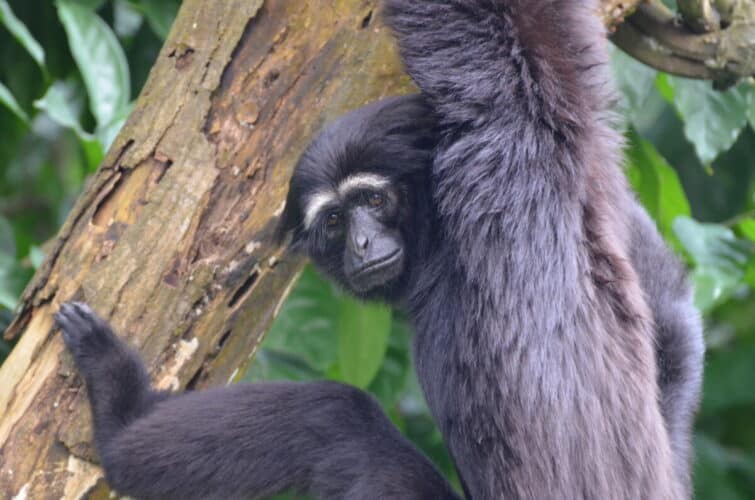
Western Hoolock Gibbon
The Western Hoolock Gibbon, a species of gibbon found in northeastern India, Bangladesh, and Myanmar, has been the subject of numerous conservation efforts due to its vulnerable status. Habitat loss remains a significant threat to their survival, as deforestation continues to diminish suitable habitats.
Vocalizations play a crucial role in their social behavior, with distinct calls serving various purposes such as territorial defense and mate attraction. These calls are characterized by loud hoots and whoops that can be heard over long distances.
The Western Hoolock Gibbon exhibits monogamous mating systems and typically gives birth to a single offspring every two years. Successful reproduction is dependent on the availability of suitable habitats and an abundance of food resources.
Efforts must continue to protect their habitats and mitigate the effects of habitat loss for the long-term survival of this species.
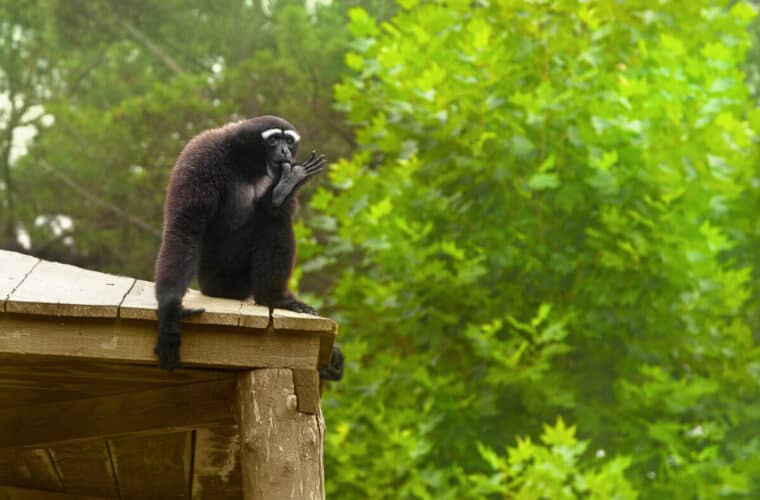
Eastern Hoolock Gibbon
Endemic to the forests of Northeast India and Western Myanmar, the Eastern Hoolock Gibbon is an extraordinary primate that captivates with its graceful movements and hauntingly melodic calls.
Conservation efforts for this species have been implemented due to their declining population.
The habitat of Eastern Hoolock Gibbons consists of dense tropical rainforests, where they primarily feed on fruits, leaves, and flowers.
They are highly social animals, living in small family groups consisting of a monogamous pair and their offspring.
Reproduction in Eastern Hoolock Gibbons is characterized by long-term pair bonds and a slow rate of reproduction with only one offspring every two to three years.
Vocalizations play a significant role in their social interactions and communication within group members, facilitating spacing, mate attraction, and territorial defense.
Understanding these aspects is crucial for conserving this remarkable primate species.
Skywalker Hoolock Gibbon
Characterized by its acrobatic abilities and striking appearance, the Skywalker Hoolock Gibbon is a primate species found in the forests of China, Myanmar, and India. Conservation efforts for this species have been implemented due to its declining population.
Vocalizations play a crucial role in communication among Skywalker Hoolock Gibbons, with each family group having their own unique call. These calls are used to establish territory boundaries and locate other groups.
Their habitat consists of tropical rainforests and evergreen forests where they primarily feed on fruits, leaves, flowers, and insects.
Reproduction in Skywalker Hoolock Gibbons typically occurs once every two years, with females giving birth to a single offspring. Family structures consist of monogamous pairs along with their dependent young.
The main threats faced by this species include habitat loss due to deforestation and illegal hunting for bushmeat trade. Efforts are being made to address these challenges through conservation initiatives and protected area management plans.
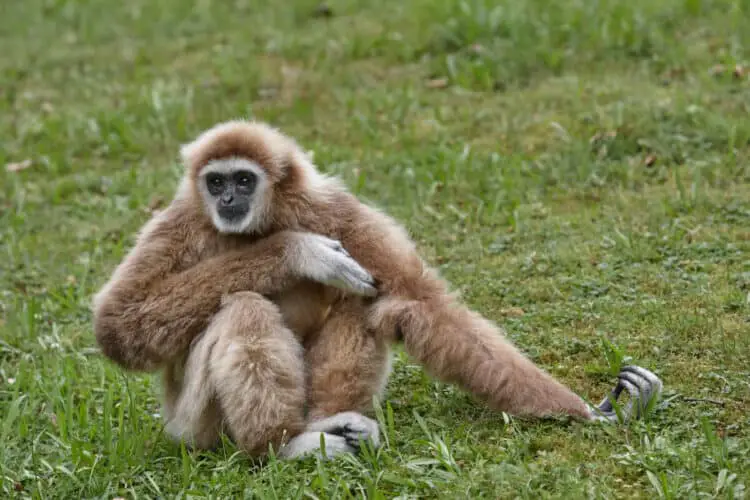
Lar Gibbon
Found in the forests of Southeast Asia, the Lar Gibbon is known for its graceful movements and distinct vocalizations that serve as a means of communication within family groups.
Their behavior patterns involve living in small, monogamous family units where both parents share responsibilities such as grooming and caring for their offspring.
Conservation efforts are crucial due to habitat loss caused by deforestation and illegal hunting.
These arboreal primates inhabit the tropical rainforests and prefer dense, mature canopies where they swing effortlessly from tree to tree.
Their diet mainly consists of fruits, leaves, and occasionally insects.
Vocalizations play a vital role in lar gibbons’ communication, with each member having unique songs that establish territorial boundaries and strengthen social bonds within their group.
Reproduction occurs every two to three years, with females giving birth to a single offspring which receives care from both parents until it reaches sexual maturity.
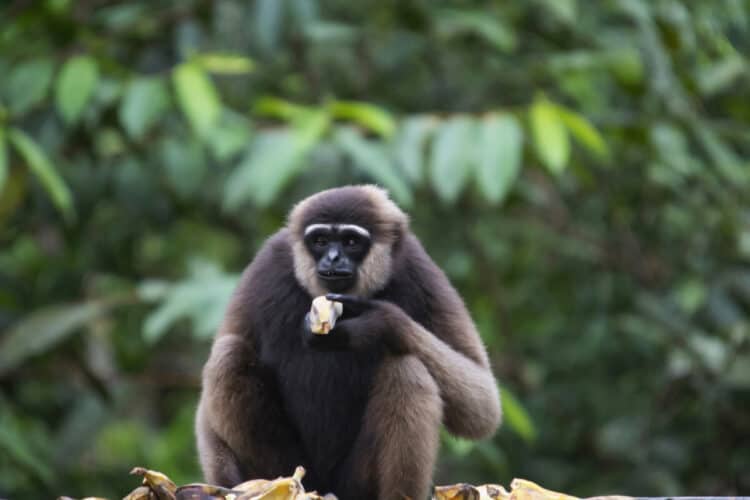
Bornean White-bearded Gibbon
The Bornean White-bearded Gibbon is a highly unique primate species found in the rainforests of Borneo, captivating researchers and nature enthusiasts alike with its striking appearance and intriguing behaviors.
Conservation efforts for the Bornean white bearded gibbon are crucial due to its vulnerable status. The destruction of its habitat through deforestation poses a significant threat to its survival. Efforts are being made to protect and restore these forests, as well as establish protected areas for the gibbons.
Additionally, research and study on this species are essential for understanding its unique characteristics and behavior. This includes studying their vocalizations, which play a vital role in communication within social groups. Understanding their habitat requirements and preferences is also important for conservation efforts.
By identifying key resources such as food availability, suitable tree structures for traveling and sleeping, conservationists can better protect these primates’ habitats and ensure their long-term survival.
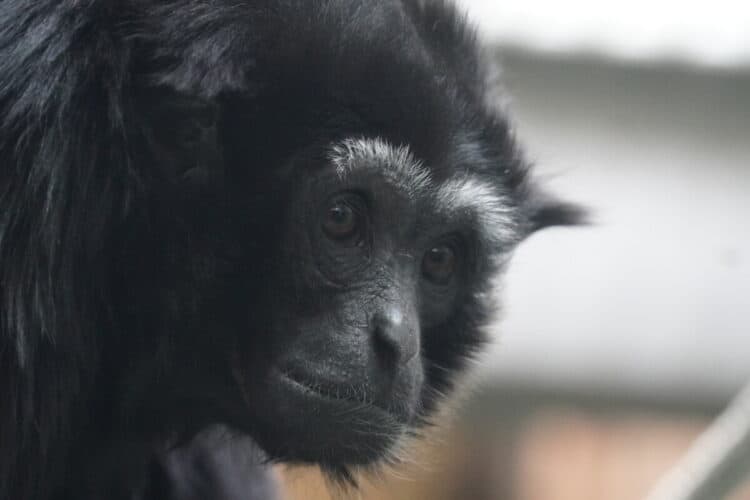
Agile Gibbon
One intriguing aspect of the agile gibbon is its unique locomotion, which allows it to effortlessly swing and leap through the forest canopy.
Agile gibbons are highly social primates that live in small family groups consisting of a mated pair and their offspring.
They communicate using a variety of vocalizations, including songs that are used to defend territory and attract mates.
Their diet primarily consists of fruits, leaves, and insects, which they forage for in the trees.
Agile gibbons have adapted physical characteristics such as long arms and strong shoulder joints that enable them to move swiftly through the treetops.
Unfortunately, these remarkable creatures are facing significant threats due to habitat loss and hunting, resulting in their classification as endangered on the IUCN Red List.
Conservation efforts are crucial to ensure their survival in the wild.
Western Grey Gibbon
Characterized by its distinctive gray fur and melodic vocalizations, the Western Grey Gibbon inhabits the forests of Southeast Asia. These arboreal primates are known for their agile movements and long limbs, which enable them to swing effortlessly through the forest canopy. They typically form monogamous pairs and live in small family groups consisting of a male, female, and their offspring. The Western Grey Gibbon’s diet primarily consists of fruits, leaves, and insects.
The habitat of the Western Grey Gibbon includes primary evergreen forests and secondary growth forests. However, due to deforestation and habitat fragmentation caused by human activities such as logging and agriculture expansion, their population has significantly declined over recent years. As a result, the conservation status of this species is now listed as critically endangered.
One notable characteristic of the Western Grey Gibbon is its unique vocalizations. These songs serve multiple purposes including territorial defense, mate attraction, and communication within family groups. By studying these vocalizations, researchers can gain valuable insights into their behavior patterns.
Efforts are being made to conserve this species through protected areas establishment, raising awareness about their importance in maintaining healthy ecosystems and implementing sustainable forest management practices. However, continued conservation efforts are necessary to ensure the survival of this remarkable primate species in its natural habitat.
Eastern Grey Gibbon
Adorned with a silvery-white fur and emitting enchanting melodies, the Eastern Grey Gibbon gracefully roams through the lush forests of Southeast Asia. This species, known scientifically as Nomascus nasutus, is closely related to the Western Grey Gibbon but exhibits some distinct characteristics.
Eastern grey gibbons are generally smaller in size, with males weighing around 7 kilograms and females around 5 kilograms. They possess longer arms compared to their western counterparts, enabling them to effortlessly swing from branch to branch.
Conservation status of eastern grey gibbons is alarming due to habitat loss and hunting for their body parts. Vocalizations play a crucial role in communication among these gibbons, allowing them to establish territories and attract mates. Their diet primarily consists of fruits, leaves, flowers, and insects.
Unfortunately, deforestation for agriculture and illegal pet trade pose significant threats to their survival. It is imperative that conservation efforts be intensified to protect this magnificent species from extinction.
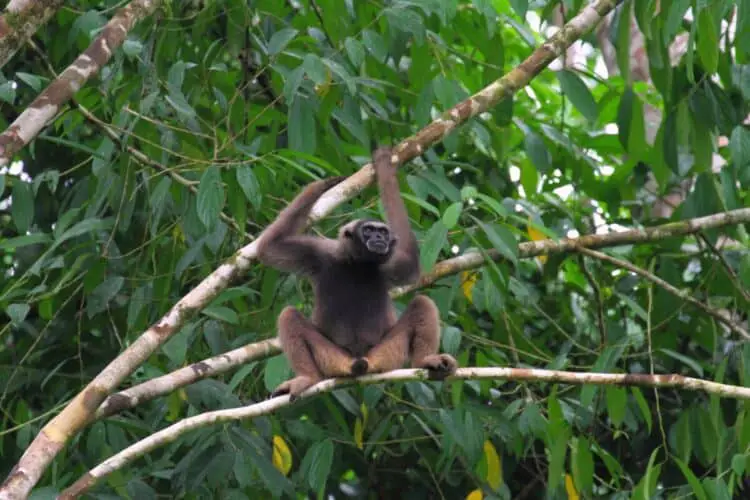
Müller’s gibbon
Müller’s gibbon, known scientifically as Hylobates muelleri, is a primate species found in the rainforests of Southeast Asia. Conservation efforts have been implemented to protect this endangered species due to habitat loss and illegal hunting.
Müller’s gibbons primarily inhabit lowland rainforests and rely on a diet consisting mainly of fruits, leaves, and flowers. They are known for their distinctive vocalizations which serve as an important means of communication within social groups. These vocalizations include territorial calls, songs, and duets between mates.
Müller’s gibbons typically form monogamous pair bonds and engage in cooperative parenting, with both parents actively participating in caring for their offspring. However, they face numerous threats including deforestation, fragmentation of their habitat, and poaching for the pet trade.
Efforts are being made to mitigate these challenges and ensure the long-term survival of Müller’s gibbons in the wild.
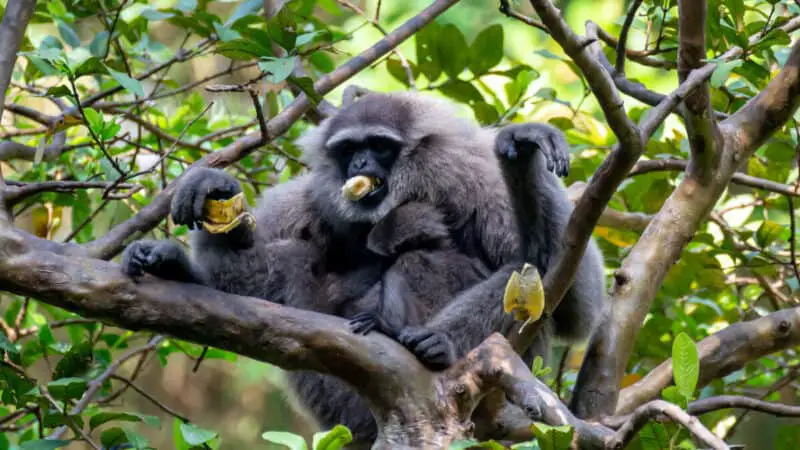
Silvery Gibbon
Moving on from Müller’s gibbon, we now turn our attention to the silvery gibbon (Hylobates moloch). This species, also known as the Javan gibbon, is native to the islands of Java and Bali in Indonesia.
The evolutionary history of the silvery gibbon remains enigmatic due to limited fossil records. However, genetic studies have shed some light on their phylogenetic relationships within the genus Hylobates.
Conservation efforts for this species are crucial as they face severe threats from habitat loss and fragmentation caused by deforestation and agriculture expansion. Silvery gibbons are renowned for their complex vocalizations, which play a vital role in communication and territorial defense within their forested habitats.
They exhibit strong habitat preferences for primary rainforests but can also adapt to disturbed forests. Socially, silvery gibbons form monogamous pairs with offspring staying with parents until reaching sexual maturity, displaying a remarkable sense of family cohesion within their small social groups.
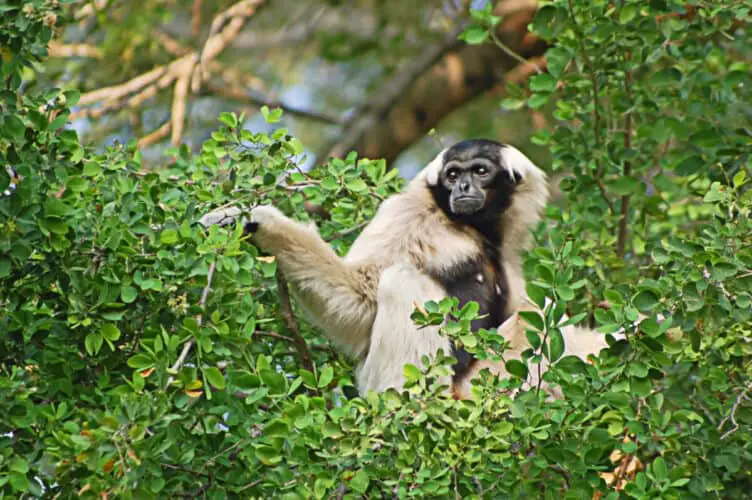
Pileated Gibbon
The evolutionary history and social dynamics of the pileated gibbon (Hylobates pileatus) remain a subject of scientific inquiry, as researchers strive to uncover the intricate relationships within this enigmatic species.
Pileated gibbons are known for their unique behavior and habitat preferences, which contribute to their conservation status. These primates inhabit dense tropical rainforests in Southeast Asia, including countries like Thailand, Myanmar, and Malaysia. They primarily stay in the canopy, using their long arms to swing from branch to branch with agility and ease.
Pileated gibbons have a frugivorous diet consisting mainly of fruits, leaves, flowers, and occasionally insects.
Unfortunately, due to deforestation and habitat fragmentation caused by human activities such as logging and agriculture expansion, the pileated gibbon faces significant threats to its survival. Consequently, it has been categorized as an endangered species by the International Union for Conservation of Nature (IUCN), emphasizing the need for effective conservation strategies to safeguard its future existence.
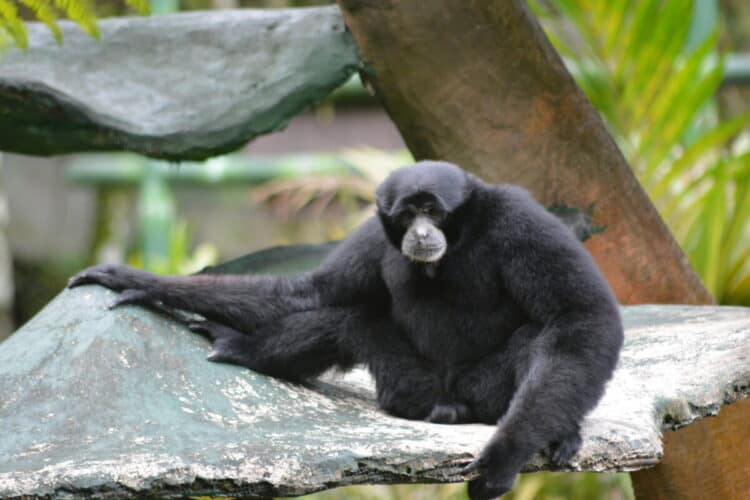
Kloss’s Gibbon
Kloss’s gibbon (Hylobates klossii) is a primate species found in Southeast Asia, particularly in countries such as Thailand, Malaysia, and Indonesia. This gibbon has an intriguing evolutionary history, with close relatives including other gibbon species and orangutans.
It primarily inhabits lowland tropical rainforests and montane forests, displaying a preference for dense vegetation. Kloss’s gibbons are known for their unique vocalizations and communication methods, which include loud calls that can carry over long distances.
However, due to habitat loss and fragmentation caused by deforestation and agricultural expansion, the population of Kloss’s gibbons has been declining rapidly. As a result, this species is currently listed as endangered on the IUCN Red List of Threatened Species.
Conservation efforts are crucial to mitigate these threats and ensure the survival of this remarkable primate species.
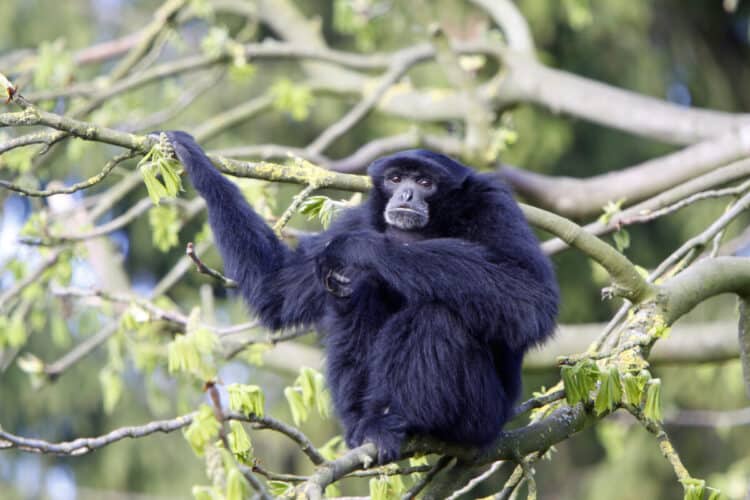
Siamang
An intriguing primate found in Southeast Asia, the siamang has a distinctive appearance and highly developed vocal abilities. Siamangs are known for their loud and melodic calls, which can be heard up to 2 miles away. They use these vocalizations to communicate with other members of their social group and establish territory boundaries.
Siamangs are primarily herbivorous, with their diet consisting mainly of fruits, leaves, and flowers. They have long arms and strong muscles that allow them to move swiftly through trees using a mode of locomotion called brachiation.
The siamang’s habitat is threatened by deforestation, leading to a decline in population numbers. Conservation efforts are crucial to protect this species from further loss of habitat.
Physically, siamangs are characterized by their black fur, large throat sacs, and webbed fingers that aid in tree climbing.
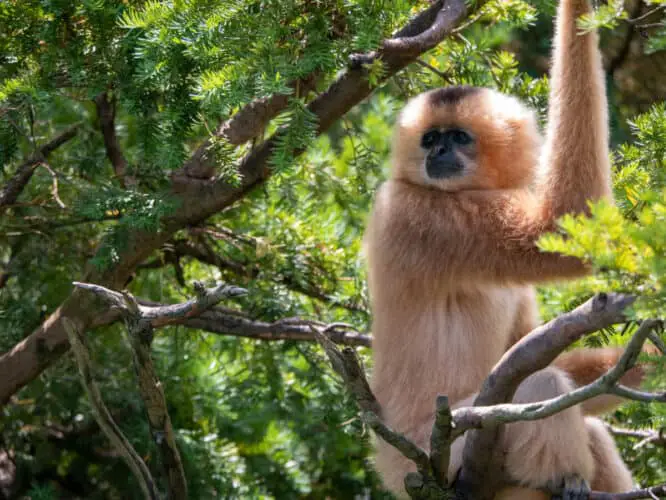
Northern Buff-cheeked Gibbon
Northern Buff-cheeked Gibbons are arboreal primates found in Southeast Asia, known for their graceful movements and unique vocalizations that resonate through the dense forest canopy. These gibbons are categorized as endangered by the International Union for Conservation of Nature (IUCN) due to habitat loss and fragmentation caused by human activities such as deforestation and agriculture expansion.
Conservation efforts have been initiated to protect their habitats and promote population recovery. Habitat preservation is crucial for the survival of Northern Buff-cheeked Gibbons, as they rely on intact forests for food resources and shelter.
Vocalizations play a significant role in communication and maintaining social bonds within gibbon groups. They use calls to establish territories, attract mates, and communicate with other individuals over long distances.
The behavior of Northern Buff-cheeked Gibbons is characterized by monogamy, where a male-female pair forms a stable bond along with their offspring. However, these gibbons face various threats and challenges including poaching for the illegal pet trade, hunting, and climate change impacts on their habitats.
Efforts need to be intensified to conserve this species and address the underlying issues affecting its survival.
Black Crested Gibbon
The Black Crested Gibbon, an arboreal primate found in Southeast Asia, faces numerous threats to its survival including habitat loss and fragmentation caused by human activities such as deforestation and agriculture expansion. Conservation efforts have been put in place to mitigate these threats and protect the species.
The gibbon’s habitat loss has resulted in decreased availability of suitable living spaces and food resources, leading to population decline. Vocalizations and communication play a crucial role in this species’ social structure and reproduction. They use loud calls to maintain territories, attract mates, and communicate with their offspring.
Reproduction and parenting behaviors among black crested gibbons are characterized by long-term monogamy, paternal care, and strong bonds between parents and offspring. Predation is also a significant threat to this species, with large birds of prey being their primary predators.
Efforts must continue to ensure the conservation of the Black Crested Gibbon’s population amid increasing habitat destruction.
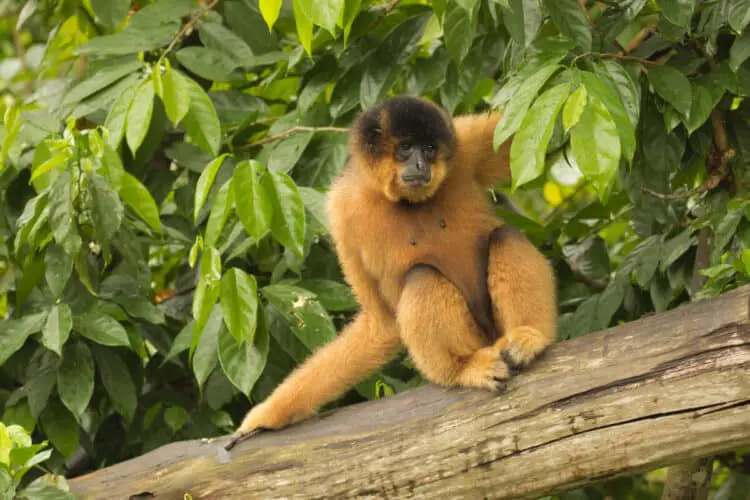
Eastern Black Crested Gibbon
A significant threat to the Eastern Black Crested Gibbon’s survival is habitat loss and fragmentation caused by human activities such as deforestation and agriculture expansion. Conservation efforts are being made to mitigate these threats and protect the species.
In terms of habitat and diet, Eastern Black Crested Gibbons primarily inhabit tropical rainforests in Southeast Asia and feed on fruits, leaves, and insects. They are known for their loud vocalizations that serve as a form of communication within their social groups.
Reproduction and parenting in this species involve monogamous pairs raising a single offspring together. However, the population of Eastern Black Crested Gibbons faces numerous challenges including poaching for illegal wildlife trade, hunting, and the lack of protected areas.
Implementing effective conservation strategies is crucial for ensuring the long-term survival of this endangered species.
Hainan Black Crested Gibbon
Endemic to the island of Hainan, the Black Crested Gibbon is facing severe threats to its survival due to habitat loss and fragmentation caused by human activities such as deforestation and agriculture expansion.
Conservation efforts have been implemented to mitigate these challenges and protect this species from extinction. The gibbons’ natural habitats are being conserved through the establishment of protected areas and reforestation initiatives. Additionally, educational programs are being conducted to raise awareness about the importance of preserving their habitat.
Vocalizations play a crucial role in social behavior among Hainan Black Crested Gibbons, serving as a means of communication between group members and for territorial defense. However, increased anthropogenic disturbances can disrupt their vocal communication networks.
Furthermore, reproduction challenges arise due to limited availability of suitable mate choices and decreased fertility rates caused by habitat degradation.
Overall, concerted efforts are needed to address these issues and ensure the long-term survival of the Hainan Black Crested Gibbon population on the island of Hainan.
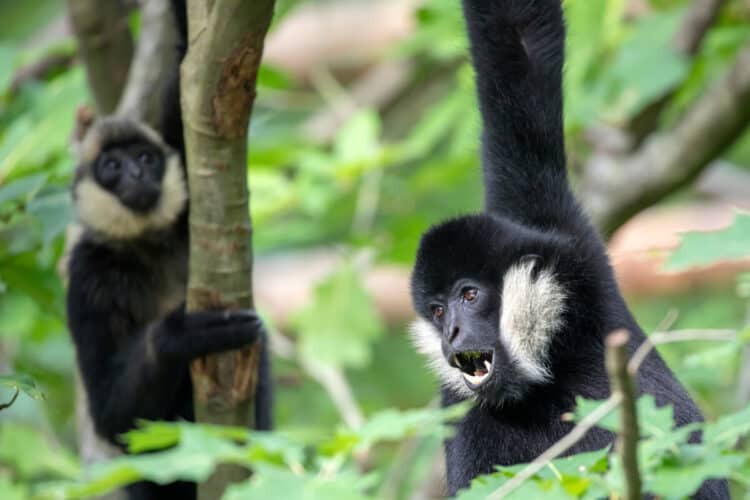
Northern White-cheeked Gibbon
The Hainan Black Crested Gibbon, previously discussed, now gives way to the Northern White-cheeked Gibbon (Nomascus leucogenys), another species of gibbon found in Southeast Asia. Conservation efforts for this species are crucial due to its endangered status caused by habitat loss and fragmentation.
The Northern White-cheeked Gibbon resides in tropical rainforests and is primarily arboreal. It exhibits a monogamous mating system with long-term pair bonds and territorial behavior. Reproduction patterns involve a slow life history strategy, characterized by low reproductive rates and extended inter-birth intervals.
Vocalizations play a vital role in communication among individuals within social groups, serving as territory defense mechanisms and facilitating mate attraction. Understanding the vocal repertoire and social behavior of the Northern White-cheeked Gibbon is essential for conservation strategies aimed at preserving this unique primate species in its rapidly changing environment.
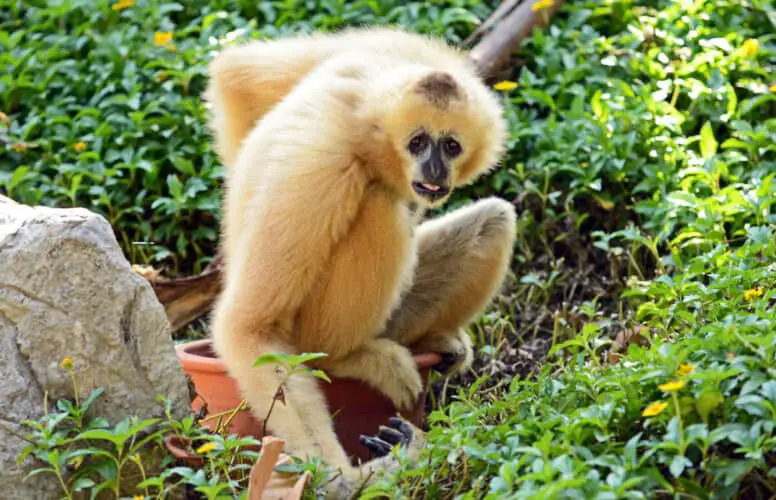
Southern White-cheeked Gibbon
Southern White-cheeked Gibbons, found in southern Laos, Vietnam, and Cambodia, face similar threats as their northern counterparts, including habitat loss and fragmentation due to deforestation. Conservation efforts have been put in place to protect their populations and habitats. These efforts aim to mitigate the impact of habitat loss by establishing protected areas and promoting sustainable land use practices.
Reproduction patterns of Southern White-cheeked Gibbons are characterized by a slow reproductive rate, with females giving birth only once every 2-3 years. Vocalizations play a crucial role in their social behavior and communication within groups. These vocalizations include loud songs that can travel long distances through the forest canopy.
The conservation of this species requires a comprehensive understanding of its habitat requirements, reproduction patterns, vocalizations, and social behavior to develop effective strategies for protection and management.
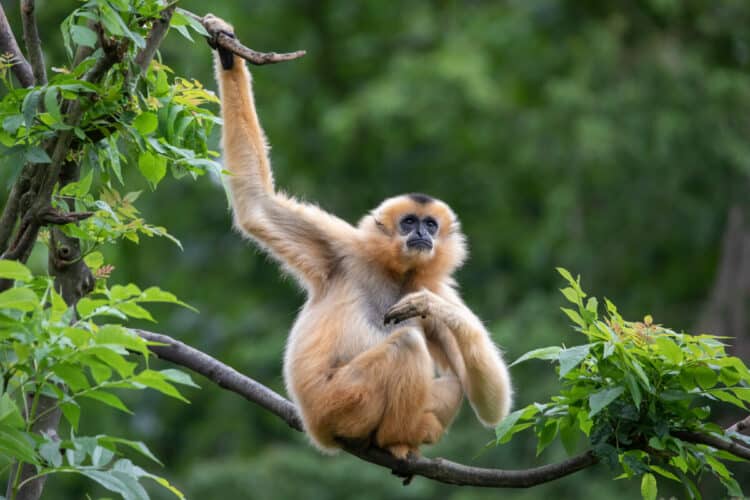
Yellow-cheeked Gibbon
Yellow-cheeked Gibbons, found in the forests of Vietnam and Cambodia, face threats such as habitat loss and fragmentation due to deforestation. Conservation efforts have been implemented to protect their populations and habitats.
Yellow-cheeked Gibbons primarily inhabit evergreen forests and rely on a diet consisting of mainly fruits, leaves, flowers, and insects.
Vocalizations play an essential role in their communication, with various calls used for different purposes such as territorial defense or finding mates.
Social behaviors among Yellow-cheeked Gibbons include forming monogamous pairs with strong bonds between mates and cooperative group living within territories.
Reproduction occurs once every two years, with females giving birth to a single offspring after a gestation period of around seven months.
Parenting is shared between both parents, with males playing an active role in rearing the young through carrying them on their bodies and providing protection.
